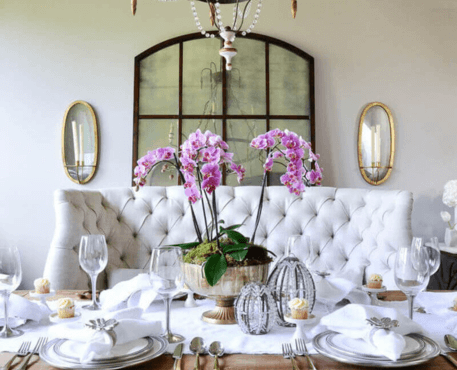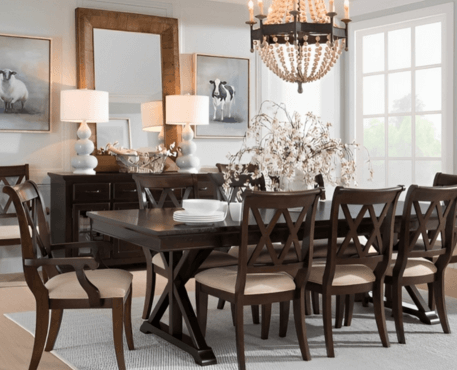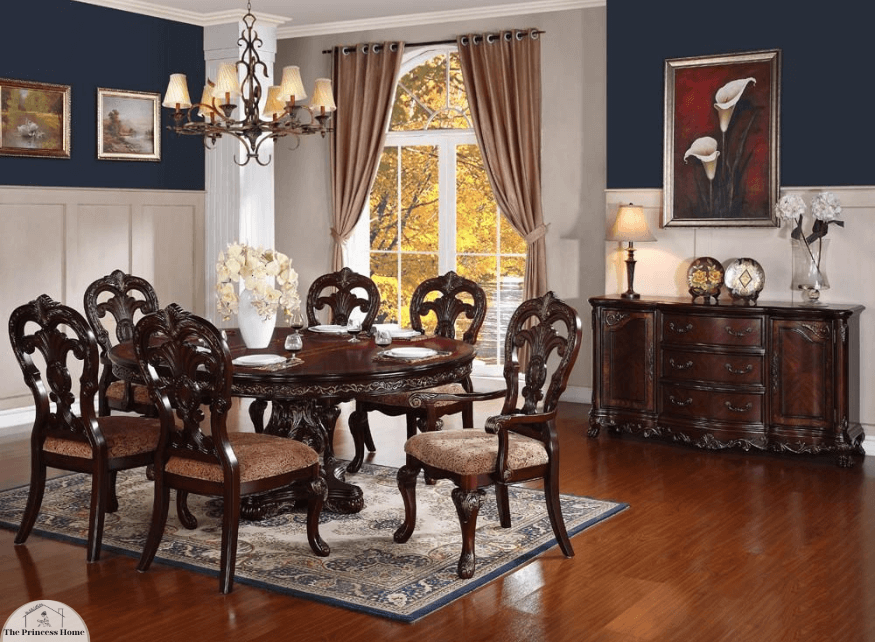
The Right Dining Room Furniture :The dining room is more than just a place to eat; it’s a space where families gather, friends come together, and meaningful conversations are had. The right dining room furniture can significantly enhance this experience, transforming your space into a warm, inviting, and functional area. However, selecting the perfect dining room furniture involves careful consideration of various factors, including your space, style preferences, and practical needs. This essay explores a comprehensive guide on how to choose the right dining room furniture to create a harmonious and comfortable environment.
Choosing the right dining room furniture involves a thoughtful and systematic approach that takes into account your space, style preferences, and practical needs. By carefully assessing your available space, defining your style, selecting the appropriate table and seating, considering storage solutions, and maintaining proportion and scale, you can create a dining room that is both visually appealing and functional. Remember that quality and durability are paramount for furniture that will stand the test of time. With these considerations in mind, you can curate a dining space that invites warmth, comfort, and cherished moments for years to come.
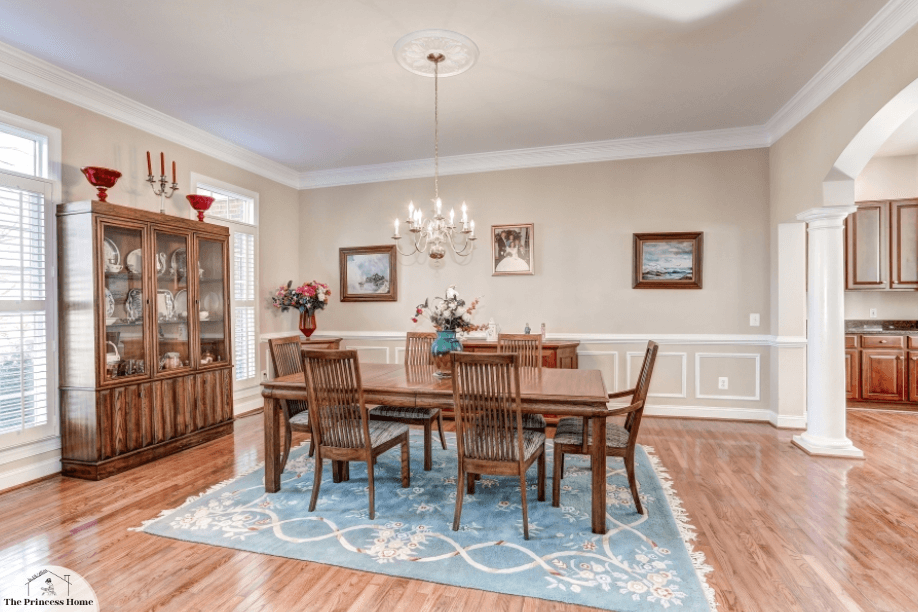
1.Assess Your Space
Before embarking on the journey to select dining room furniture, it’s essential to assess the available space. Consider the dimensions of the room, the layout, and any architectural features that might influence furniture placement. A larger room might accommodate bulkier furniture, while a smaller space would require more streamlined options. Take accurate measurements and create a layout plan to visualize how different furniture pieces will fit and interact within the space.
Assessing your dining room space is a crucial first step in making informed decisions about furniture selection and arrangement. Here are some key considerations to keep in mind when assessing your dining room space:
1.Room Dimensions:
- Measure the length and width of the room to understand the available floor space accurately.
- Take note of any alcoves, nooks, or architectural elements that might affect the placement of furniture.
2.Layout:
- Consider the overall layout of the room, including doorways, windows, and other openings.
- Determine the focal point of the room, such as a fireplace or a large window, and plan the furniture arrangement around it.
3.Traffic Flow:
- Identify the natural traffic flow within the room. Ensure that there’s enough space for people to move comfortably between the dining area and other parts of the house.
4.Functionality:
- Define the primary function of the dining room. Is it primarily used for formal dinners, casual meals, or multipurpose activities? This will influence the type of furniture you choose.
5.Seating Capacity:
- Determine the number of people you want to accommodate regularly. This will guide the size and quantity of dining chairs and the table.
6.Style and Aesthetics:
- Consider the overall style and aesthetic of the room. The existing color scheme, wall treatments, and flooring should complement the furniture you choose.
7.Lighting:
- Take note of the available lighting in the room. Ensure that the dining area is well-lit, either naturally or with artificial lighting.
8.Storage Needs:
- Assess your storage requirements. If you need additional storage for dinnerware, table linens, or other items, factor this into your furniture choices.
9.Future Flexibility:
- Think about the potential for changes in the future. Will the room be used for different purposes, or might there be changes in the number of occupants? Choose furniture that allows for adaptability.
10.Budget:
- Determine your budget for dining room furniture. Knowing your budget constraints will help you narrow down your choices and focus on options that are within your financial range.
By carefully assessing these factors, you can create a well-planned dining room that not only meets your functional needs but also enhances the overall aesthetic appeal of your home.
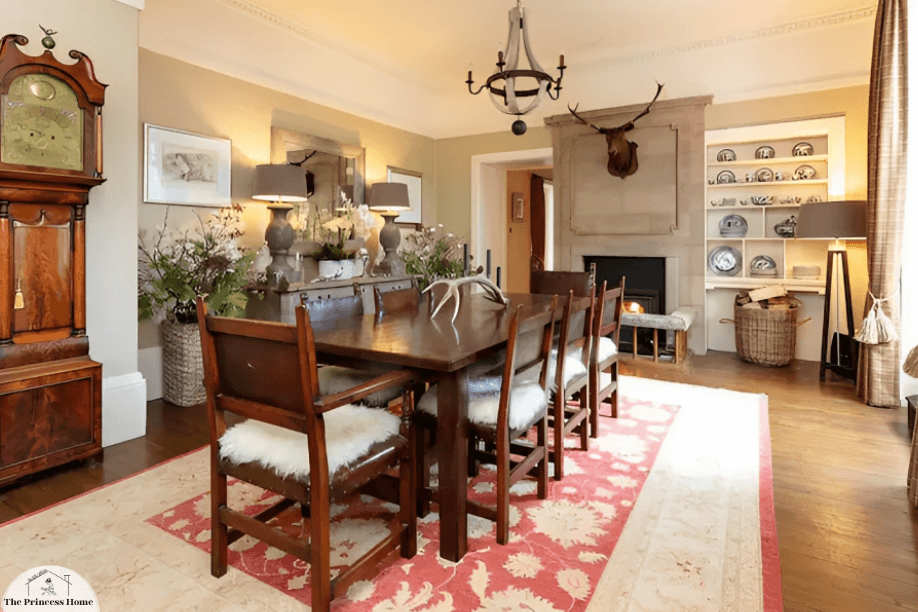
2.Define Your Style
Your dining room furniture should reflect your personal style and complement the overall aesthetics of your home. Are you drawn to traditional, contemporary, rustic, or minimalist designs? Identifying your style preferences will help narrow down your options and maintain consistency with the existing decor. Consider factors such as color schemes, materials, and design motifs that resonate with you and harmonize with your home’s interior design.
Defining your style is a crucial step in selecting dining room furniture that aligns with your personal preferences and complements the overall design of your home. Here are some popular interior design styles to consider, along with key characteristics of each:
1.Traditional:
- Classic and timeless designs.
- Rich and warm color palettes, often featuring dark wood tones.
- Ornate detailing, such as intricate carvings and moldings.
- Formal and elegant furniture pieces, like upholstered chairs and large, sturdy tables.
2.Contemporary:
- Clean lines and sleek, modern aesthetics.
- Neutral color schemes with occasional pops of bold colors.
- Use of materials like glass, metal, and lacquered finishes.
- Focus on functionality and simplicity in design.
3.Rustic:
- Emphasis on natural materials like wood and stone.
- Earthy color palettes with warm, inviting tones.
- Distressed or reclaimed wood for a weathered look.
- Cozy and comfortable with a connection to nature.
4.Minimalist:
- Simple and uncluttered design.
- Neutral color schemes, often with whites, grays, and blacks.
- Use of clean lines and functional furniture.
- Emphasis on open space and a “less is more” philosophy.
5.Transitional:
- Blend of traditional and contemporary elements.
- Neutral color palettes with a mix of classic and modern furniture.
- Balance between ornate details and clean lines.
- Comfortable and inviting without being overly formal.
6.Eclectic:
- Mix and match of various styles and eras.
- Bold color combinations and diverse patterns.
- Personalized and unique furniture pieces.
- Reflects individuality and a curated, collected-over-time look.
7.Mid-Century Modern:
- Clean lines and functional designs from the mid-20th century.
- Use of materials like plywood, metal, and plastic.
- Organic shapes and iconic furniture pieces.
- Bright, bold color choices and a sense of openness.
When defining your style, consider the existing design elements in your home and choose dining room furniture that harmonizes with these elements. Whether you prefer the warmth of traditional furniture, the sleekness of contemporary designs, or the charm of rustic pieces, selecting furniture that aligns with your style will create a cohesive and visually appealing dining space.
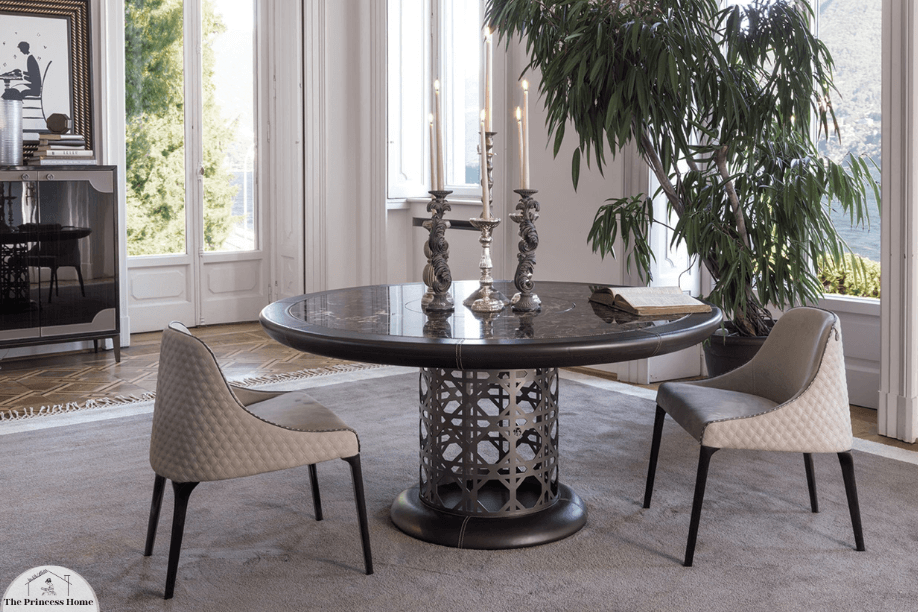
3.Choose the Right Table
The dining table is the focal point of the room and a crucial decision. Select a table that accommodates the number of people you typically host and fits comfortably within your space. Round tables are ideal for promoting conversation, while rectangular tables offer more formal seating arrangements. Extendable tables are a practical choice for versatile hosting. Material options range from wood, glass, and metal, each with its unique charm and durability.
Choosing the right dining table is a key decision as it not only serves as the focal point of the room but also plays a central role in facilitating comfortable dining experiences. Here are some considerations to guide you in selecting the right dining table:
1.Size and Shape:
- Consider the size of your dining room and the number of people you intend to accommodate regularly.
- Round tables are great for promoting conversation and work well in smaller spaces. They also eliminate sharp corners, making them safer, especially in homes with children.
- Rectangular tables are more formal and are suitable for larger dining rooms. They provide a defined seating arrangement and work well for hosting larger gatherings.
2.Extendable Tables:
- If you entertain guests frequently or have varying numbers of diners, consider an extendable table. This allows you to adjust the table size based on your needs, providing versatility.
3.Material:
- Wood: Wooden tables, such as those made from oak, walnut, or maple, are classic and durable. They add warmth and character to the dining space.
- Glass: Glass tables create a modern and airy feel. They can visually expand the room and are easy to clean. However, they may require more maintenance to keep them looking pristine.
- Metal: Tables with metal frames or surfaces provide a contemporary and industrial look. They are often durable and easy to maintain.
4.Style Compatibility:
- Choose a table that aligns with your overall interior design style. Whether it’s traditional, contemporary, rustic, or eclectic, the table should complement the existing aesthetics of the room.
5.Budget:
- Determine your budget for the dining table. This will help narrow down your options and guide you towards choices that are within your financial range.
6.Practicality:
- Consider how easy the table is to clean and maintain, especially if you have a busy household or young children.
- Assess the durability of the material, ensuring it can withstand daily use and potential wear and tear.
7.Height:
- Ensure that the table height is comfortable for dining. Standard dining tables are typically around 30 inches tall, but variations exist. Make sure the chairs or seating you choose complement the table height.
Remember that the dining table is a long-term investment, and choosing one that fits both your functional needs and design preferences is essential. Take your time exploring different options, and if possible, test the comfort and functionality of tables in person before making a decision.
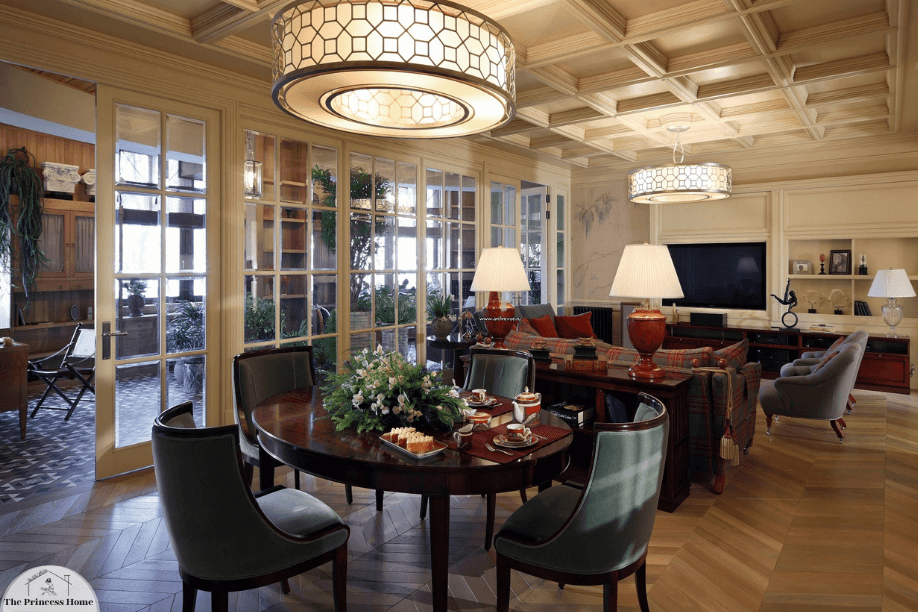
4.Select Appropriate Seating
When choosing dining chairs, prioritize comfort and aesthetics. The chairs should complement the table in terms of style and height. Upholstered chairs provide added comfort, while wooden or metal chairs are more low-maintenance. Mix and match chair styles for an eclectic look or stick to a uniform design for a cohesive appearance. Additionally, consider bench seating, which can save space and accommodate more guests.
Selecting appropriate seating for your dining room is essential for creating a comfortable and visually appealing space. Here are some considerations to help you choose the right dining chairs:
1.Comfort:
- Prioritize comfort, especially if you plan to spend extended periods at the dining table. Consider chairs with well-padded seats and supportive backs.
2.Aesthetics and Style:
- Choose chairs that complement the style of your dining table and the overall design of the room. Whether your style is traditional, contemporary, or eclectic, the chairs should harmonize with the table and other elements in the space.
3.Height:
- Ensure that the height of the chairs is appropriate for the table. The seat height should allow for comfortable dining, with the tabletop sitting at a standard height of around 30 inches.
4.Upholstery vs. Non-Upholstered:
- Upholstered chairs provide extra comfort and can add a touch of luxury to the dining room. However, they may require more maintenance and cleaning.
- Non-upholstered chairs, such as those made of wood or metal, are often more low-maintenance and easier to clean. They can contribute to a sleek and minimalist aesthetic.
5.Mix and Match or Uniform Design:
- Consider whether you want a uniform set of chairs for a cohesive look or if you prefer mixing and matching different styles for a more eclectic vibe. Mixing chair styles can add visual interest to the dining space.
6.Bench Seating:
- Bench seating is a practical and space-saving option. It can accommodate more guests and creates a casual, communal atmosphere. Consider using a bench on one side of the table and chairs on the other for a balanced look.
7.Materials:
- Choose materials that align with the overall style of the room and are easy to maintain. Common materials include wood, metal, plastic, and upholstered fabrics.
8.Practical Considerations:
- If you have young children, consider chairs with easy-to-clean surfaces and durable materials that can withstand spills and messes.
9.Quantity:
- Ensure you have enough chairs to accommodate the number of people you plan to host regularly. If space allows, consider having a few extra chairs for larger gatherings.
10.Test for Comfort:
- If possible, try out the chairs before purchasing. Sit in them to assess comfort and make sure they are suitable for extended periods of use.
By carefully considering these factors, you can choose dining chairs that enhance both the functionality and aesthetics of your dining room, creating a welcoming space for meals and gatherings.
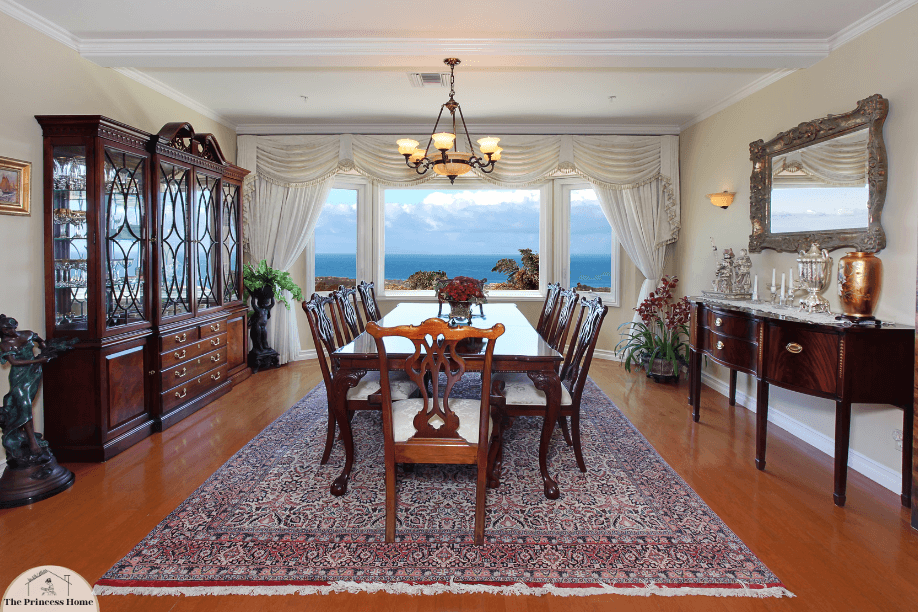
5.Consider Storage Solutions
Dining room furniture can also serve functional purposes, such as storage. Buffets, sideboards, and display cabinets provide convenient storage for dinnerware, cutlery, and table linens. These pieces can enhance the room’s aesthetic appeal while keeping essential items within easy reach during meal times and gatherings.
Integrating storage solutions into your dining room can enhance both the functionality and aesthetic appeal of the space. Here are some popular storage furniture options to consider:
1.Buffets and Sideboards:
- Buffets and sideboards are versatile pieces that offer ample storage space. They typically feature a combination of drawers, cabinets, and open shelves.
- Use them to store dinnerware, serving dishes, and linens, making it easy to access these items during meals.
- Choose a buffet or sideboard that complements the style of your dining table and chairs.
2.Display Cabinets:
- Display cabinets combine storage with the opportunity to showcase decorative items, fine china, or glassware.
- Opt for cabinets with glass doors to create an elegant display while keeping items protected from dust.
- Consider built-in lighting within the cabinet to highlight displayed items.
3.Hutches:
- Hutches are similar to buffets but typically include a set of shelves or cabinets placed on top for additional storage or display space.
- They are often taller and can be a focal point in the room, providing a substantial amount of storage.
4.Wine Racks:
- If you enjoy entertaining with wine, consider a wine rack or a wine cabinet. These can be standalone pieces or incorporated into other storage furniture.
- Look for designs that provide both bottle and glass storage.
5.Credenzas:
- Credenzas are long, low cabinets that often have a combination of drawers and shelves. They can serve as stylish storage solutions in the dining room.
- Use them to store items like table linens, candles, or extra serving pieces.
6.Built-In Shelving:
- Consider built-in shelving if you have the flexibility to customize your dining room space. This allows you to tailor storage solutions to your specific needs and the available space.
7.Multipurpose Furniture:
- Explore furniture pieces that serve dual purposes, such as a dining table with built-in storage or benches that open up to reveal hidden storage compartments.
8.Material and Finish:
- Choose storage furniture that complements the materials and finishes of your existing dining room furniture. Consistency in style and color can create a cohesive look.
9.Space Considerations:
- Be mindful of the available space in your dining room when selecting storage solutions. Ensure that the furniture doesn’t overwhelm the room but rather enhances its functionality.
Adding storage solutions to your dining room not only helps keep the space organized but also allows you to showcase and access essential items with ease. Choose pieces that align with your design preferences and contribute to the overall aesthetic of the room.
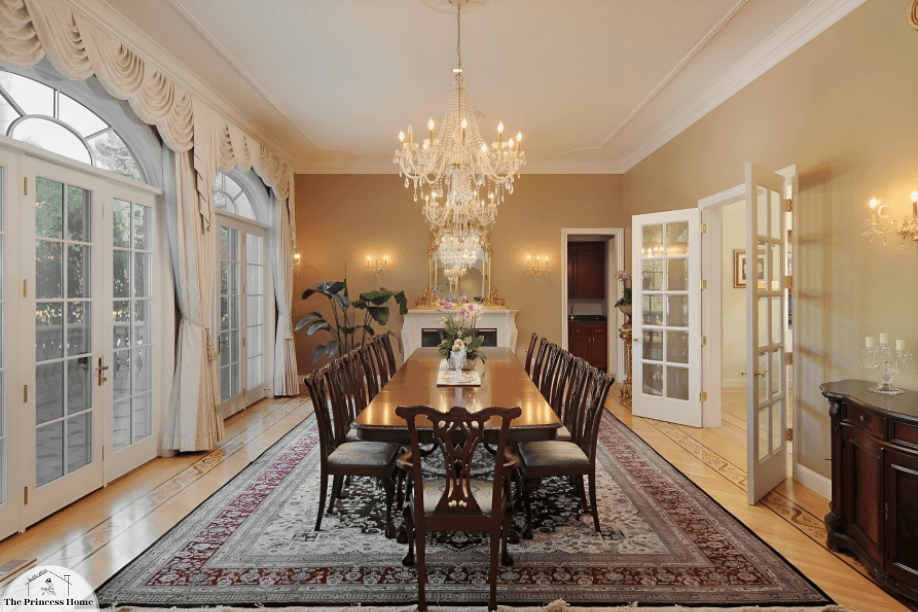
6.Maintain Proportion and Scale
Maintaining proportion and scale is crucial to creating a balanced and visually appealing dining room. Avoid overcrowding the space with oversized furniture, which can make the room feel cramped. Conversely, undersized furniture can appear insignificant and out of place. Strive for harmony by selecting furniture pieces that fit well within the dimensions of the room and complement each other in terms of size and scale.
Maintaining proportion and scale is indeed fundamental for creating a well-balanced and visually pleasing dining room. Here are some key tips to ensure proportion and scale in your furniture choices:
1.Room Measurements:
- Begin by accurately measuring the dimensions of your dining room. This includes the length, width, and any architectural features.
- Use these measurements as a guide when selecting furniture to ensure that pieces fit comfortably within the available space.
2.Furniture Size and Placement:
- Consider the size of each furniture piece in relation to the room. The dining table should be proportionate to the room size and allow enough space for chairs to be pulled out comfortably.
- Avoid overcrowding by leaving ample space around each furniture piece. This not only ensures a visually balanced look but also promotes ease of movement within the room.
3.Table-to-Room Ratio:
- Maintain a balanced table-to-room ratio. If the room is spacious, a larger dining table may be suitable. In smaller rooms, opt for a table that allows for comfortable seating without dominating the space.
4.Chair Dimensions:
- Pay attention to the dimensions of dining chairs in relation to the table. Chairs should provide enough seating without appearing too bulky or too small in comparison to the table.
- Ensure that there is sufficient space between chairs for diners to sit comfortably and maneuver easily.
5.Consider Ceiling Height:
- Take into account the height of the room when selecting furniture. Taller ceilings may accommodate larger or more substantial furniture pieces, while lower ceilings might benefit from sleeker, lower-profile options.
6.Visual Weight:
- Assess the visual weight of each furniture piece. Dark or bulky items may appear heavier than lighter or more streamlined pieces. Distribute visual weight evenly to maintain balance.
7.Create Harmony with Style:
- Ensure that the style of each furniture piece is harmonious. While mixing styles can add interest, it’s important to maintain a cohesive overall look by balancing contrasting elements.
8.Focal Point:
- If your dining room has a focal point, such as a fireplace or a large window, consider how the scale of your furniture complements or enhances this feature.
9.Use of Mirrors and Lighting:
- Mirrors can create the illusion of more space and enhance the sense of proportion in a room. Strategic placement of mirrors can reflect light and make the room feel more open.
- Thoughtfully chosen lighting fixtures contribute to the overall scale of the room. Ensure that pendant lights or chandeliers are proportionate to the dining table and the room as a whole.
By paying attention to proportion and scale, you can create a dining room that feels comfortable, visually balanced, and well-suited to its overall size and layout.
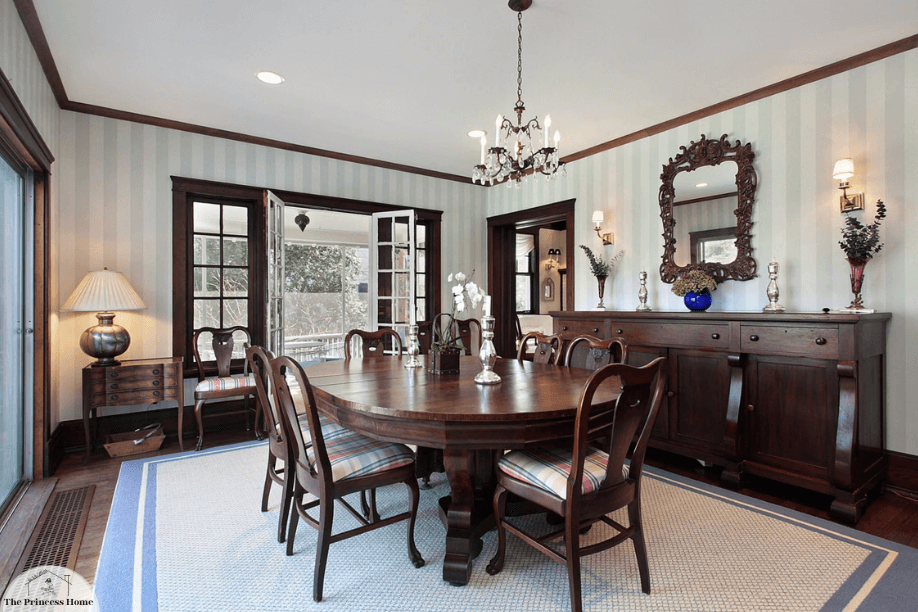
7.Quality and Durability
Investing in high-quality dining room furniture is a wise decision for longevity and comfort. Quality materials such as solid wood, sturdy metal frames, and durable upholstery will ensure that your furniture stands the test of time. While high-quality pieces might come with a higher upfront cost, they often prove to be more cost-effective in the long run due to their extended lifespan.
Investing in high-quality dining room furniture is a prudent decision that can bring long-term benefits in terms of durability, comfort, and overall satisfaction. Here are several reasons why prioritizing quality is essential:
1.Longevity:
- High-quality materials and craftsmanship contribute to the longevity of furniture. Well-made pieces are more likely to withstand daily wear and tear, maintaining their structural integrity over the years.
2.Durability:
- Quality furniture is built with durability in mind. This is particularly important in the dining room, where furniture is subjected to regular use, spills, and potential impacts. Durable materials such as solid wood and sturdy metal frames resist damage and ensure a longer lifespan.
3.Comfort:
- Comfort is a key factor in enjoying your dining space. High-quality upholstery and padding on chairs provide lasting comfort, making meals and gatherings more enjoyable.
4.Aesthetic Appeal:
- Quality furniture often exhibits superior aesthetics. Fine craftsmanship, attention to detail, and high-end materials contribute to a polished and refined appearance that enhances the overall look of your dining room.
5.Resale Value:
- Should you decide to update your dining room furniture in the future, high-quality pieces tend to retain better resale value. Quality craftsmanship and materials are often appreciated by potential buyers.
6.Cost-Effectiveness in the Long Run:
- While high-quality furniture may come with a higher upfront cost, it can prove to be more cost-effective in the long run. Lower-quality, budget-friendly options may need to be replaced more frequently, resulting in higher cumulative costs over time.
7.Environmental Impact:
- Quality furniture is often made from sustainable materials and produced with environmentally conscious practices. Choosing high-quality, durable pieces can contribute to a reduction in furniture waste.
8.Customization and Personalization:
- High-quality furniture often allows for customization and personalization. This allows you to choose materials, finishes, and details that align with your preferences and the overall design of your home.
9.Brand Reputation:
- Reputable furniture brands are known for their commitment to quality. Researching and choosing furniture from well-regarded manufacturers can give you confidence in the durability and craftsmanship of your purchases.
10.Warranty and Customer Support:
- High-quality furniture often comes with warranties and reliable customer support. This adds an extra layer of assurance, providing recourse in case of manufacturing defects or issues.
When investing in dining room furniture, it’s worth considering the long-term benefits that come with high-quality pieces. Prioritize materials, craftsmanship, and reputable brands to ensure that your dining room is furnished with durable, comfortable, and aesthetically pleasing furniture.

4. Select Appropriate Seating
Dining chairs are more than just seating; they contribute to the room’s overall aesthetics. If you’re aiming for a cohesive look, choose chairs that share design elements with the table. Alternatively, mixing different chair styles can add a touch of eclecticism and personality to the space. Remember to prioritize comfort, especially if you often have long gatherings around the table. Ergonomically designed chairs with proper back support can enhance the dining experience.
Conclusion
Selecting the right dining room furniture involves a harmonious blend of style, practicality, and comfort. By assessing your space, defining your style, and carefully considering the size and design of the table, chairs, and storage solutions, you can curate a dining area that reflects your personality while catering to your functional needs. Remember that the dining room is a space for connection and shared moments, and the right furniture can enhance these experiences for you, your family, and your guests. Through a thoughtful approach, you can create a dining room that is not only aesthetically pleasing but also a true heart of your home.
Certainly, here are some frequently asked questions
Q1: How do I determine the right size of dining table for my space?
A: Determining the right size of a dining table involves considering both the available space and the number of people you plan to seat regularly. Measure the dimensions of your dining area, leaving enough room for chairs to be comfortably pulled out. For rectangular tables, allow at least 24 inches of width per person along the table’s length. Round tables should have a diameter of at least 48 inches for comfortable seating. If space is limited, consider extendable tables that can be adjusted to accommodate different group sizes.
Q2: Can I mix different chair styles around my dining table?
A: Absolutely! Mixing different chair styles can add character and visual interest to your dining room. To ensure a cohesive look, focus on a unifying element such as color, material, or design details. For instance, you could choose chairs with similar colors but varying designs, or opt for chairs made from the same material but with distinct shapes. Just be mindful of maintaining a balanced composition to avoid a chaotic or mismatched appearance.
Q3: What’s the advantage of using storage furniture like buffets or sideboards in the dining room?
A: Storage furniture like buffets and sideboards offer practical benefits by providing ample space to store dining essentials such as extra dinnerware, glassware, and table linens. They also serve as a surface for serving dishes during meals or displaying decorative items. Additionally, they can enhance the overall aesthetics of the room, acting as focal points or complementing the dining table and chairs. This functional and decorative versatility makes them a valuable addition to any dining space.
Q4: How important is the quality of dining room furniture?
A: The quality of dining room furniture is paramount for several reasons. High-quality furniture is often built to withstand regular use and wear, ensuring longevity. It’s an investment that saves you money in the long run, as you won’t need to replace items as frequently. Quality materials and craftsmanship contribute to the overall aesthetics and comfort of the furniture, enhancing your dining experience. When choosing furniture, prioritize durability, solid construction, and reliable materials to ensure your investment stands the test of time.
Q5: What if I have a small dining area? How can I make the most of the space?
A: In a small dining area, space optimization is key. Opt for round or oval tables as they promote better flow and accommodate more people in a limited space. Consider benches or backless seating, which can be tucked under the table when not in use, saving space. Wall-mounted or foldable tables are great options for extremely tight spaces. Additionally, choose light-colored furniture and mirrors to create an illusion of more space. Keep clutter to a minimum and prioritize multi-functional furniture that serves your specific needs without overwhelming the room.
Q6: How do I create a cohesive look in my dining room while incorporating different furniture pieces?
A: To create a cohesive look in your dining room, establish a unifying theme or color palette that runs through all the furniture pieces. Consider the design elements such as materials, finishes, and shapes. Match the style of the dining table with the chairs, and coordinate these with storage furniture, if present. Incorporate complementary textiles like tablecloths, cushions, or curtains that echo the chosen theme. A consistent design language ensures that each furniture piece contributes to a harmonious and balanced overall aesthetic.
Q7: What are some tips for arranging furniture in an open-concept dining and living area?
A: In an open-concept space, it’s important to delineate separate areas while maintaining a sense of unity. Use rugs or lighting fixtures to define the dining area visually. Choose furniture that complements both spaces, such as coordinating colors or materials. Arrange furniture to allow for smooth movement between the two areas, and consider furniture with versatile designs, like bar carts that can transition between dining and entertaining spaces. Thoughtful placement and consideration of traffic flow ensure that each area remains functional and distinct within the open layout.
Q8: Can I mix different types of materials, such as wood and metal, in my dining room furniture?
A: Mixing materials can create an interesting and dynamic aesthetic in your dining room. Combining materials like wood and metal can add contrast and visual appeal. The key is to maintain a balanced ratio of each material and ensure that they harmonize in terms of color, texture, and style. For example, a wooden dining table with metal legs can be paired with metal-framed chairs to create a cohesive yet eclectic look. Just be mindful of maintaining a sense of unity to prevent the space from feeling disjointed.
Q9: How can I create a formal dining room atmosphere without making it feel too rigid?
A: To create a formal dining room atmosphere without making it feel rigid, consider a blend of classic and contemporary elements. Opt for a formal dining table with elegant details, but pair it with more relaxed seating like upholstered chairs or a mix of chair styles. Incorporate softer colors and textures in the decor to add warmth and comfort. Enhance the formality with decorative elements like chandeliers or wall art, but balance them with personal touches that reflect your own style. The goal is to create an inviting and sophisticated space that still feels approachable.
Q10: How often should I update my dining room furniture?
A: The frequency of updating dining room furniture depends on several factors, including the quality of the furniture, changes in your personal style, and wear and tear. High-quality, well-maintained furniture can last for decades, while lower-quality pieces might need to be replaced sooner. Changes in your lifestyle, such as growing family needs or moving to a new space, might also prompt updates. Regularly assess the condition of your furniture and consider whether it still meets your functional and aesthetic requirements.



